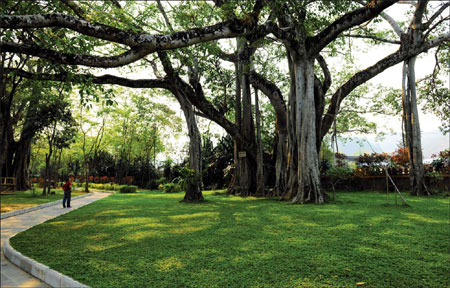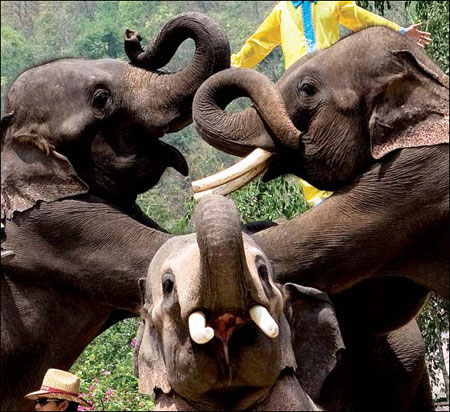Tropical utopia
Updated: 2013-05-24 09:11
(China Daily)
|
|||||||||||

|
Top: The 900-year-old banyan tree in the town of Daluo gives the impression of a forest with its spreading roots. Above: An elephant show at Wild Elephant Valley. Provided to China Daily |
Xishuangbanna, Home to China's last wild elephants, a vast expanse of rainforest and unique local culture, is a perfect escape into nature
Lying on the Mekong River in Yunnan province, Xishuangbanna is the only tropical rainforest nature reserve in China and home to the country's last wild elephants.
Often called Aerial Garden and previously known as Mengbanaxi, which means fantastic utopia, the region offers an escape into luxuriously tropical forest alive with animals and insects.

It is also home to 13 ethnic groups. The majority group is the Dai. Others include the Hani, Wa and Yao.
Before becoming a tourist draw for its elephants and nature, the area was famous for Water Sprinkling Festival, which marks the Dai peoples' new year. Lasting three days, from April 13 to 15, on the first day cultural performances are held and there are dragon boat races. On day two people sprinkle water on each other as a way of expressing good wishes. And on the third day, people exchange gifts.
Although Water Sprinkling Festival has already passed this year, there are many other events to come, including dragon boat races, firing of indigenous missiles and flying Kongming Lamps.
For those traveling on from China, the 966-kilometer border with Myanmar and Laos is a main crossing point into southern parts of Asia.
Here are also some of the region's main attractions:
1. Wild Elephant Valley
Among the Dai people, elephants are a sign of good luck and longevity so it is perhaps fate that the last wild elephants in China live in Xishuangbanna.
About 45 kilometers from Jinghong city, the region's capital, Wild Elephant Valley is equipped with viewing platforms.
Three hundred elephants live in the dense forest of Xishuangbanna, known locally as the "kingdom of elephants".
An elephant training school in the valley houses 16 tamed elephants that have been taught to perform tricks such as bowing, standing on their heads, dancing and kicking balls. Tourists can ride the elephants, have their photograph taken with them or enjoy an elephant massage.
2. Single Tree Forest
This 900-year-old Banyan tree in the town of Daluo is a favorite scenic spot for many. With more than 30 different strands of surfacing roots, the "forest" it creates spans 120 square meters beneath its towering 70-meter-tall trunk.
Aerial roots growing from the trunk twist and cross each other on their way to the ground, creating the feeling that there are many trees.
3. Manfeilong Buddhist Pagoda
Situated on the top of a hill near Manfeilong village, 70 kilometers from Jinghong city, the Manfeilong Pagoda was built in 1024.
Because of its appearance it is also known by two other names, White Pagoda and Bamboo Shoot Pagoda. It is dedicated to Hinayana Buddhism, which is a small, conservative branch of Buddhism.
The Manfeilong Pagoda consists of nine towers. The main tower is 16.3 meters tall and surrounded by eight smaller towers, each 9.1 meters tall.
Made of bricks, with club-like bases topped by calabash-shaped bodies, each tower contains a niche in which sits a Buddhist statue.
To the south of the pagoda is a footprint in the rock, which according to legend was left by Sakyamuni, the founder of Buddhism.
The pagoda attracts Buddhists from Myanmar and Thailand, and during the Water Sprinkling Festival crowds of Dai people from Manfeilong village gather in front of the pagoda to celebrate the new year.
4. Olive Dam
Named for its shape, Olive Dam (Ganlanba) is the lowest and hottest place in Xishuangbanna and home to the Dai people, who live in wooden houses on stilts. The two main Dai villages are Mansongman (garden village) and Manting (fruit garden).
Located along Lancang River and known for its beauty, the region, which holds a bounty of tropical fruits, is also sometimes called Menghan, which means roll up.
The name comes from a legend that when the Buddhist preacher Sakyamuni came to the area his followers laid out a cotton cloth for him to walk on, which they later rolled up.
China Daily
(China Daily 05/24/2013 page23)
Today's Top News
List of approved GM food clarified
ID checks for express deliveries in Guangdong
Govt to expand elderly care
University asks freshmen to sign suicide disclaimer
Tibet gears up for new climbing season
Media asked to promote Sino-Indian ties
Shots fired at Washington Navy Yard
Minimum growth rate set at 7%
Hot Topics
Lunar probe , China growth forecasts, Emission rules get tougher, China seen through 'colored lens', International board,
Editor's Picks

|

|

|

|

|

|






